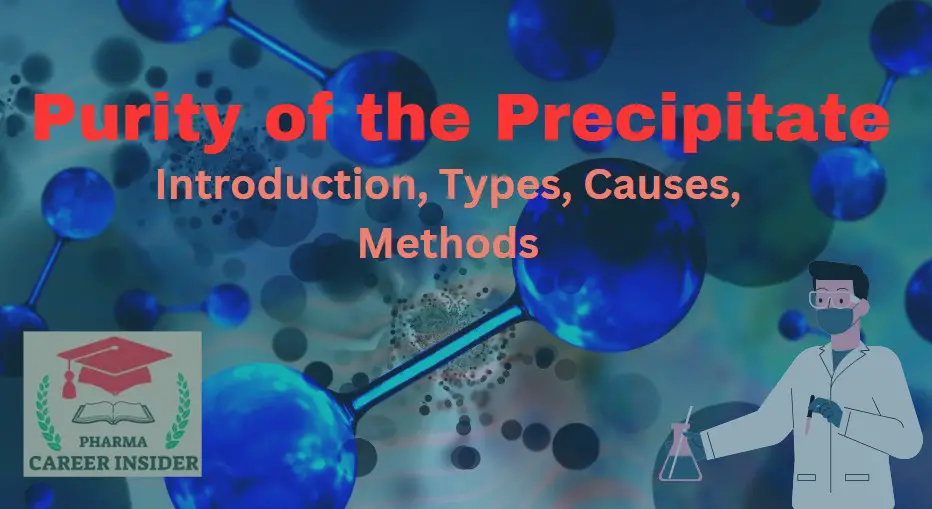Introduction
Gravimetric analysis is one of the most precise and accurate methods for determining the quantity of an analyte in a sample. However, the accuracy of the results heavily depends on the purity of the precipitate formed during the analysis. Any impurity incorporated in the precipitate can lead to systematic errors and affect the final mass measurement.
During precipitation, unwanted foreign substances can contaminate the precipitate in two main ways:
- Co-precipitation: This occurs when impurities are incorporated into the precipitate during its formation.
- Post-precipitation: This happens when unwanted substances subsequently form on or around the primary precipitate after its formation.
These contamination processes can alter the stoichiometric composition of the precipitate and affect analytical accuracy. Understanding the causes, effects, and prevention methods of these phenomena is crucial for obtaining high-purity precipitates in gravimetric analysis.
1. Co-precipitation
Co-precipitation is the simultaneous precipitation of impurities along with the desired analyte, even when the impurities are normally soluble under the given conditions. It usually occurs during the formation of the main precipitate.
Causes of Co-precipitation
- Rapid precipitation: When precipitation occurs too quickly, impurities may get trapped within the crystal lattice or between growing crystals.
- Presence of similar ions: If an impurity ion is chemically similar to the analyte, it may replace the analyte in the crystal structure.
- Electrostatic interactions: Charged species in solution can adhere to the precipitate surface.
Types of Co-precipitation
1. Inclusion
- It occurs when an impurity ion substitutes for the analyte in the crystal lattice due to its similar size and charge.
- Example: Bromide (Br−) or iodide (I−) replacing chloride (Cl−) in the precipitation of silver chloride (AgCl).
2. Occlusion
- Occurs when foreign ions or molecules become physically trapped inside the growing crystal.
- Example: Rapid precipitation of barium sulfate (BaSO4) may lead to sulfate ions being trapped inside the crystal.
3. Surface Adsorption
- Impurities adhere to the outer surface of the precipitate due to electrostatic attraction.
- Example: Silver chloride (AgCl) particles can adsorb excess silver ions (Ag+), affecting purity.
4. Mechanical Entrapment
- Occurs when small particles of impurities become trapped between closely packed crystals during rapid precipitation.
Effects of Co-precipitation
- This leads to overestimated analyte mass.
- Alters the composition of the precipitate.
- Affects the solubility and filtration properties of the precipitate.
Methods to Minimize Co-precipitation
- Slow precipitation by adding the precipitating agent gradually.
- Digestion (Ostwald ripening): Allow the precipitate to sit in solution at a slightly elevated temperature to promote crystal growth and expulsion of impurities.
- Wash the precipitate with a suitable solvent to remove surface impurities.
- Use complexing agents or masking agents to prevent undesired ions from precipitating.
2. Post-precipitation
Post-precipitation occurs when a secondary precipitate forms after the initial precipitation is complete. This can lead to contamination and affect the composition of the final precipitate.
Causes of post-precipitation
- Supersaturation of secondary ions that react slowly over time to form an additional precipitate.
- Changes in pH promote the delayed precipitation of another compound.
- Extended standing time before filtration, allowing new precipitates to form.
Example of post-precipitation
- Mohr’s method for chloride determination uses silver nitrate (AgNO3) to precipitate silver chloride (AgCl), but if the solution stands too long, excess silver ions react with chromate (CrO42−), forming a secondary precipitate of silver chromate (Ag2CrO4), leading to errors.
Effects of post-precipitation
- Leads to inaccurate results due to the inclusion of secondary precipitates.
- Alters the mass of the main precipitate, leading to overestimation.
Methods to Minimize Post-precipitation
- Immediate filtration after precipitation to prevent unwanted reactions.
- Controlling pH to prevent secondary precipitation reactions.
- Using masking agents to prevent unwanted ions from forming secondary precipitates.
- Adjusting temperature to reduce slow crystallization of other species.
Conclusion
Ensuring the purity of the precipitate is essential for obtaining accurate and reliable results in gravimetric analysis. Co-precipitation and post-precipitation introduce impurities that can affect the composition, solubility, and weight of the precipitate. Proper precipitation control, washing, digestion, and filtration techniques can significantly minimize these errors, leading to high-purity analytical results.


Intresting information. Very easy formate.
Thanku you team
Keep updating
thank you for feedback
Hi, Ι do think this is a great web site. I stumbledupon it 😉 I may return yet again since i have bookmarked
it. Money and freedom is the greatest way to change, may
you be rich and continue to help other people.